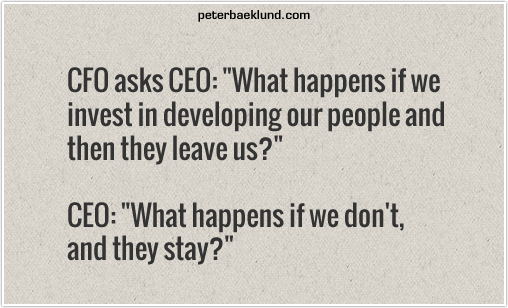 As families gather in the United States this week to celebrate the Thanksgiving holiday there will likely be a common inconsistency in their stories. Many will likely be thankful for the job that they currently have even though they are considerably dissatisfied with that job. With the economic downturn organizations have been so focused on squeezing out costs from their operations that most have neglected investing in their people. The result is that most employees are at a historically low level of engagement with their employers.
As families gather in the United States this week to celebrate the Thanksgiving holiday there will likely be a common inconsistency in their stories. Many will likely be thankful for the job that they currently have even though they are considerably dissatisfied with that job. With the economic downturn organizations have been so focused on squeezing out costs from their operations that most have neglected investing in their people. The result is that most employees are at a historically low level of engagement with their employers.
Recently the CEO of Gallup, Jim Clifton, wrote a blog post on “A Failing Global Workplace.” In the post he cited Gallup’s recent report on the State of the Global Workplace where only 13% of employees worldwide are truly engaged in their jobs. No that’s not a typo, only 13% of employees are emotionally invested in and focused on creating value for their organizations every day. Responding to those numbers, Clifton calls into question the very practice of “management” and I have to say that I agree with him. While a long term solution to this problem will take some time there is at least one way you can build employee engagement before you leave for the holiday break.
Several years ago a friend and I were talking about the role of Human Resources (HR) within large companies. At the time most large organizations had already trimmed or outsourced sizable portions of their HR departments. What remained were a few of the specialist groups like compensation, benefits, etc. and the HR generalists supporting the business units. The challenges on the HR generalists in this model have become daunting. They are supposed to liaise with all of the specialist groups and act as a primary interface in support of their business teams. With the economic downturn and the layoffs that followed the HR generalist’s job priorities were made clear- support the needs of the business units or we may not be in business for long. Leadership development, training, and other employee centric programs fell by the wayside.
Cuts to employee development programs may have been justified as a short term fix in a crisis but they certainly aren’t sustainable in the long run. Every study ever published on employee job satisfaction cites the same key determinant of employee satisfaction – the employee’s relationship with their direct manager. Most seasoned leaders recognize that good managers aren’t born, they are made. The challenge is that when organizations are not investing in their managers every employee under them is going to struggle.
The recent article Why We No Longer Need HR Departments from author and consultant Bernard Marr highlights these opposing goals. While the title may have been purposefully dramatic the suggestions that he offers align well with building good managers and developing employees. In the article Marr suggests killing the “human resources” nomenclature and replacing the department by splitting it into two halves.
By creating a People Analytics team and a People Support team the HR generalists would no longer have to struggle with the conflicting agendas of two masters. The People Analytics team would be responsible for the “run the business” elements of the HR function and the People Support team would be responsible for investing in employee development and building employee engagement.
While splitting the HR function into two components will be a big change for any organization the process of investing in your employees doesn’t have to start there. Here is one step that you can take to build employee engagement before you leave the office for your holiday celebration.
Thank each employee for their contribution and remind them of your commitment to invest in them. Take a few minutes to talk with (or email) each of your direct reports to thank them for the job they have done. If you struggle with being thankful for something that is less than perfect here is a previous post to help you frame the challenges with perfection –Time to Move Beyond Expectations of Perfection and Be Thankful for the Satisfactory.
Before you end the conversation ask them for their ideas on how you can help them develop their skills in the next year. It could be as simple as committing to spending more individual time with them. But by asking your employees what they need you are empowering them, building trust, and investing in them.
Food For Thought:
Photo Source: Peter Baeklund
Receive periodic email updates from Matt Hunt including his published pieces, updates on his progress, and more!